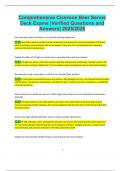Comprehensive Cicerone Beer Server
Deck Exams |Verified Questions and
Answers| 2025/2026
How does beer foam contribute to the overall drinking experience?
Beer foam releases volatile aroma compounds, enhancing the sensory perception of the beer
while providing a creamy texture and visual appeal. It also acts as an insulating barrier, helping to
maintain the beer’s temperature.
Explain the effect of UV light on certain beers, especially those with hop content.
UV light can cause a chemical reaction with hop compounds, producing a “skunky” aroma. This
reaction, known as being “lightstruck,” occurs rapidly in beers packaged in clear or green glass bottles.
Describe why using a clean glass is critical to serving draft beer properly.
A clean glass is essential because any residue—like detergent or oils—can disrupt head formation
and retention, compromise carbonation, and alter the beer’s taste and aroma, resulting in a suboptimal
drinking experience.
What could cause a draft beer with an initially large foamy head to lose its carbonation quickly when
drinking?
Poor gas balance in the draft system can lead to over-carbonation during serving, causing
excessive foaming initially. However, this process depletes CO2 from the beer itself, leaving it flat after
the foam settles.
Discuss why high-altitude draft beer systems require specific adjustments.
At high altitudes, lower atmospheric pressure can lead to over-foaming if the system pressure
isn’t correctly adjusted. Maintaining the correct balance of CO2 or nitrogen pressure is vital to avoid
excessive foam and preserve the beer's intended carbonation level.
Explain the characteristics Brettanomyces yeast brings to beer fermentation.
1
, Brettanomyces introduces distinctive flavors and aromas, often described as funky, earthy,
barnyard-like, or complexly acidic. It can contribute to unique, rustic qualities in beer, frequently sought
after in mixed fermentation and sour styles.
What causes a buttery flavor in beer and how can it be avoided during the brewing process?
A buttery flavor in beer is typically caused by diacetyl. This occurs when yeast doesn’t properly
reabsorb this compound during conditioning. Ensuring adequate conditioning time and avoiding
premature yeast removal helps prevent diacetyl off-flavors.
Identify how the shape of Weizen glasses supports the drinking experience of wheat beers.
The bulbous top and tall, narrow body of Weizen glasses enhance the beer’s foamy head,
intensifying the aromatic profile and showcasing the beer’s cloudy, yeast-driven appearance.
Describe what makes traditional Saisons distinctive from other styles.
Saisons are characterized by their complex, spicy, and fruity ester profiles, often combined with
earthy or peppery notes. This complexity is typically achieved through specific yeast strains and variable
fermentation conditions.
Why is it crucial to maintain a regular cleaning schedule for draft beer lines, especially long lines?
Regular cleaning prevents the buildup of organic materials like beer stone and yeast deposits. If
left unchecked, these deposits can harbor bacteria, taint the flavor of the beer, and lead to clogs or poor
pouring performance.
How do yeast esters contribute to a beer’s flavor profile?
Yeast esters create fruity or floral aromas and flavors in beer, adding layers of complexity. They
are most prominent in certain styles like Belgian ales, contributing notes like banana, apple, or pear,
depending on the yeast strain used.
Why is smelling beer before drinking an important part of sensory evaluation?
The aroma provides critical insights into a beer’s flavor profile since many taste perceptions are
influenced by scent. Smelling allows for the detection of subtle notes that might be missed through taste
alone.
2
, What is the purpose of adding spices such as coriander and orange peel to Belgian Witbiers?
These spices contribute distinct citrus and herbal notes, enhancing the beer’s refreshing
character and complementing its wheat base. The addition helps define the style’s unique flavor profile.
How does excessive headspace in a bottle affect the beer’s stability?
Excessive headspace increases the risk of oxidation, which can lead to off-flavors such as
cardboard or sherry-like notes, ultimately diminishing the beer’s freshness and stability.
Why is it essential to limit oxygen exposure during the brewing and packaging of beer?
Oxygen exposure can cause oxidation, leading to off-flavors such as stale, cardboard, or sherry-
like notes, and can degrade hop aroma and freshness. Proper sealing and handling techniques are
necessary to minimize this risk and preserve beer quality.
Explain how beer served at excessively cold temperatures can alter its flavor perception.
Serving beer too cold can mute its aromas and flavors, making it difficult to detect subtler notes
and nuances. This can mask both off-flavors and positive complexities, resulting in a less enjoyable
experience.
What role do hops play in beer beyond providing bitterness?
Hops contribute aroma and flavor, ranging from floral and citrusy to piney and earthy notes. They
also possess antimicrobial properties, which help to stabilize and preserve the beer.
Discuss why proper carbonation levels are critical to the beer experience.
Carbonation influences mouthfeel, aroma release, and taste perception. Too much carbonation
can lead to excessive foam and harshness, while too little can leave beer tasting flat and uninviting,
diminishing its sensory profile.
What impact does using water with high sulfate content have on beer?
High sulfate levels can enhance perceived bitterness and contribute to a dry, crisp finish, often
used to accentuate hop character in styles like IPAs. However, excessive sulfate may lead to harsh or
astringent flavors.
3




